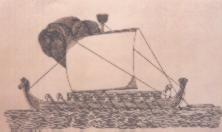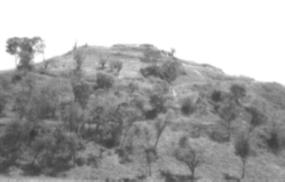Pyramids In The Pacific

The Unwritten History Of Australia
Chapter 4
|
Sumerian God-Kings and the
land of Uru.
|
'In the distant sea 100 beru of water {away]..
The ground of Arali {is}
It is where the Blue Stones cause ill,
Where the craftsman of Anu *
The Silver Axe carries, which shines
as the day
{*Anu-King of the Gods}
Ancient Sumerian text
|
Chapter
4 Images
|

|
Sumerian Galley
The ancient folklores of the Indus Valley and Sumer speak of their culture-bearing ancestors arriving from out of the Indian ocean {or as it is called in ancient Brahman Sanscrit 'Sumundra'} at the dawn of history. India's sacred book 'the Rig Veda' written between 5000-4000 BC, speaks of these culture-bearers as having arrived from a great land far across the {Indian} Ocean called Aryanam Veijo. Veijo means 'seed' and Aryanam 'Aryan's', thus "Seed of the Aryans". It was to them the land of origin of the Ayrans. Similarly, the Persians called it "Azer-baijan", or the "seed place of the Azar people", the people who worship fire, locating it in the Southern Hemisphere. Azar-baijan survives as the name of modern Armenia.
According to Babylonian mythology, the deity Ea, the god of fertilising and creative waters produced a son, Marduk, who created the {southern} Paradise by laying a reed upon the face of the waters. He then formed dust and poured it out beside the reed to create the first humans. The water-worshippers of Eridu believed that the Sun and the Moon which rose from the primordial deep, had their origins in the everlasting fire in Ea's domain at the bottom of the sea; ie the 'Underworld' Paradise of Uru. It was from this Paradise that a mysterious child came across the {Indian} Ocean to inaugurate a new era of civilisation and instruct the people how to grow corn and become warriors.
Berosus of Caldea {270-230 BC} described a race of monster beings, half-men and half-fish who, led by a great culture-bearer, Oannes, arrived on the shores of the Persian Gulf, to introduce the arts of writing, architecture and agriculture to Mesopotamia. In other words, they were skilled mariners; Gods who introduced civilisation into Mesopotamia and the rest of mankind.
The spread of Uruan culture by water craft to Mesopotamia and India could be called the first great maritime expansion; and if so, then the rise of Sumer saw another which spread Sumerian influences to the Indus Valley and Persia, to Egypt and Greece. Their vessels eventually penetrating beyond south-east Asia into the west Pacific to 'rediscover ' their 'land of origin', {the mysterious land of Uru} and sail on across the Pacific to the Americas. Sumerian influence upon the biblical world was considerable, and they provided the first ruling classes of Indus and Egyptian civilisations. The Sumerians first came to prominence around 3500BC.
The land of Sumer at first developed into a collection of fifteen or twenty small states, situated at the head of the Persian Gulf in lower Babylonia, where the Tigris and Euphrates rivers have their mouths. From here the large ocean-going reed boats of Sumer ventured forth on trade and mineral-seeking expeditions to Asia and the Middle-East. The cities, including Ur and kish, were situated far inland, but they were within trading distance with the Mediterranean lands. Archaeologists estimate that, at their height these cities supported considerable populations.
For example, Ur may have held as many as 500,000 people. The Sumerian ports of the Persian Gulf, which date from as early as the 4th millennium BC, were ideally located for trade between India and the Middle-East, although Sumerian trade was mostly directed eastwards.
|
Pyramids
in the Pacific Images Ch 4
|

|
Ancient Mining In Australia Found
by Rex Gilroy